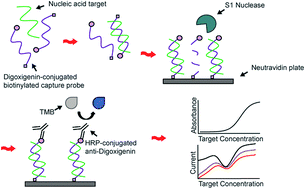A nuclease protection ELISA assay for colorimetric and electrochemical detection of nucleic acids†
Abstract
Early and accurate diagnosis is crucial to monitor infection outcomes and provide timely interventions. However, gold standard polymerase chain reaction assays (PCR) are labor-intensive and require expensive reagents and instrumentation. Nuclease protection has been used for decades to detect and quantify nucleic acid but has not yet been investigated as a diagnostic tool for infectious disease. In this work, we describe a nuclease protection enzyme-linked immunosorbent assay (NP-ELISA) for accurate and sensitive detection of nucleic acid. Briefly, binding of a nucleic acid target to an oligo probe protects it from digestion of un-hybridized nucleic acid by S1 nuclease. Following the workflow of an ELISA, a horseradish peroxidase (HRP)-conjugated antibody binds the probe and oxidizes its substrate to generate signal. The assay was validated with three HRP substrates for absorbance, chemiluminescence, and electrochemical readouts, demonstrating great versatility. Electrochemical detection with 3,3′,5,5′-tetramethylbenzidine (TMB) gave the highest assay sensitivity with a limit of detection of 3.72 × 103 molecules per mL. Furthermore, non-complementary targets did not generate a response, indicating a high degree of specificity. This proof of principle serves as a stepping stone towards developing miniaturized, multiplexed nuclease protection assays for point-of-care diagnosis.

- This article is part of the themed collection: Analytical Methods Recent HOT articles


 Please wait while we load your content...
Please wait while we load your content...
